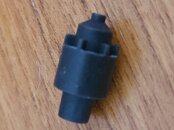It is just odd that within about a year we started having the counterbalance cylinder issues and diaphragm problems after so many years with no problems at all. When this started, LDS tech told me he was seeing problems with the cylinders and he wondered if Al had gotten a bad lot from a supplier, but at that point my reg was already several years old, so that seemed unlikely. Part was out of stock for months and I had to substitute with something else for a while.
It baffles me that three have gone south in the course of a year, so I guess I will take RSingler's advice and have the remaining ones replaced. The diaphragms I can see being a poor service skill issue, not that it makes me feel much better. When the first one was torn, LDS said it was so rare I needn't worry about it....it would probably never happen again. Then it did, on another reg.
Since every time I dive it means I am on a trip somewhere, and sometimes a long way from home on an expensive trip, and sometimes with no repair or parts available on the island, having gear fail in a way I cannot repair or work around is a real drag.
I am in Colorado and have primarily used a couple LDSs that are fairly close to me. I suppose I can just switch to the one I have not been using for service over the past several years. Both of those shops are real sticklers on the AL and SP rules, apparently living in fear of losing the "authorized" status if they violate, so I doubt I can get any diaphragms from them.
Annoyingly, one son's Scubapro reg has had no problems. Now I have to hear about that endlessly.




